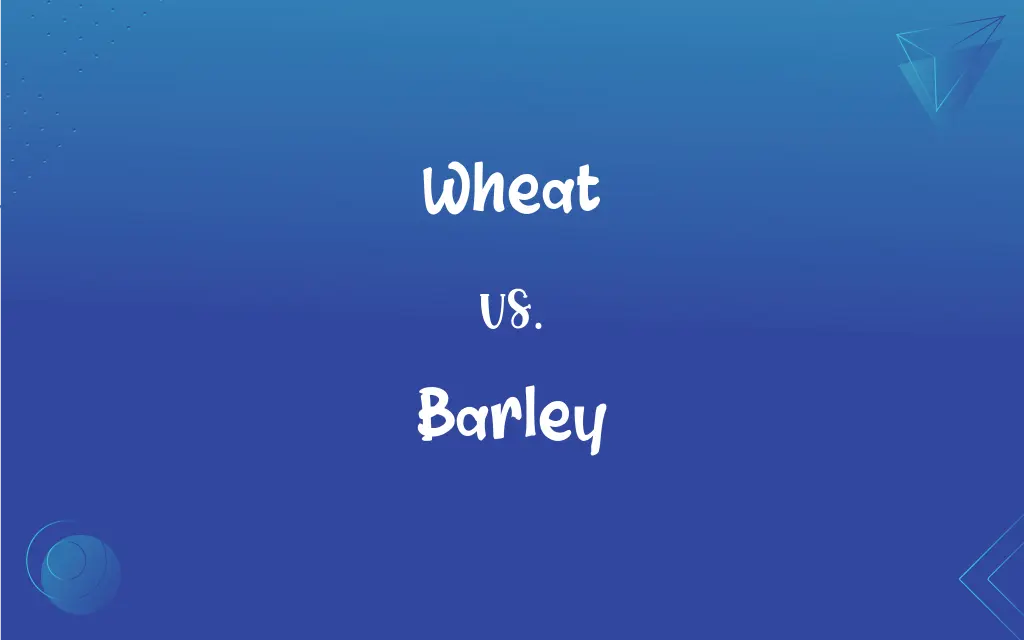Wheat vs. Barley: What's the Difference?
Edited by Janet White || By Harlon Moss || Updated on October 2, 2023
Wheat and barley are cereal grains; wheat is often used in bread due to its high gluten content, while barley is valued for malt production, notably in beverages like beer.

Key Differences
Wheat, primarily recognized for its pivotal role in bread-making due to its rich gluten content, contrasts with barley, which has lower gluten and is prominently utilized in malt production, providing a fundamental ingredient in brewing industries.
The physical appearance of wheat and barley also presents notable distinctions; wheat grains are generally more oblong and smooth, while barley tends to showcase a more robust, round grain, often enveloped by a tough, inedible hull.
In culinary contexts, wheat often becomes the flour of choice for varied baked goods, profiting from its elastic gluten properties, while barley is commonly utilized in soups and stews, offering a chewy texture and nutty flavor that enhances such dishes.
From a nutritional standpoint, wheat commonly provides a potent source of protein and fibers, particularly in its whole-grain form, whereas barley, especially in its hulled variant, offers a rich supply of fiber and presents various health benefits, including digestive support.
In agricultural and ecological contexts, wheat typically prefers slightly moist, well-drained soils and is often more sensitive to inadequate conditions, while barley is notably robust, tolerating poorer soil conditions and exhibiting resistance to dry spells, thus demonstrating versatility in diverse geographical locations.
ADVERTISEMENT
Comparison Chart
Primary Use
Predominantly in bread-making
Widely used in malt production
Grain Shape
More oblong and smooth
More robust and round, usually with a tough hull
Culinary Applications
Flour for baking goods
Often used in soups and stews
Nutritional Value
High protein and fiber content
Notably high in fiber, supports digestion
Agricultural Resilience
Slightly more sensitive to poor conditions
Tolerant to poorer soils and drier conditions
ADVERTISEMENT
Wheat and Barley Definitions
Wheat
Subject to various wheat-related allergies.
Some people avoid wheat due to gluten intolerance.
Barley
Recognized for its nutty flavor and chewy consistency.
The barley provided a satisfying chewiness to the salad.
Wheat
A cereal plant that is the most important kind grown in temperate countries.
The farmer planted wheat across the vast field.
Barley
Valued for its dietary fiber and various health benefits.
Consuming barley can support digestive health.
Wheat
Valued for its high gluten content.
The elasticity of wheat dough is due to its gluten.
Barley
A cereal grain that is commonly used in malt and fodder.
Barley is a fundamental ingredient in beer production.
Wheat
Used in various culinary dishes, primarily as a flour.
Wheat is a staple ingredient in bread-making.
Barley
Frequently utilized in hearty soups and stews.
The chef added barley to enhance the stew’s texture.
Wheat
Often found in whole or refined forms.
Whole wheat bread is denser due to its unrefined flour.
Barley
Can be consumed in various forms, such as hulled or pearled.
Hulled barley retains more nutrients than pearled barley.
Wheat
Any of various annual cereal grasses of the genus Triticum of the Mediterranean region and southwest Asia, especially T. aestivum, widely cultivated in temperate regions in many varieties for its commercially important edible grain.
Barley
A grass in the genus Hordeum native to temperate regions, having flowers in terminal, often long-awned spikes and widely cultivated for its grain.
Wheat
The grain of any of these grasses, ground to produce flour used in breads, pasta, and other foods.
Barley
The grain of H. vulgare or its varieties, used in malt production and as food for livestock and humans.
Wheat
(countable) Any of several cereal grains, of the genus Triticum, that yields flour as used in bakery.
Barley
A cereal of the species Hordeum vulgare, or its grains, often used as food or to make beer and other malted drinks.
Wheat
(uncountable) A light brown colour, like that of wheat.
Barley
(Singapore) seed of Job's tears Coix lacryma-jobi
Wheat
Wheaten, of a light brown colour, like that of wheat.
Barley
A valuable grain, of the family of grasses, genus Hordeum, used for food, and for making malt, from which are prepared beer, ale, and whisky.
Wheat
A cereal grass (Triticum vulgare) and its grain, which furnishes a white flour for bread, and, next to rice, is the grain most largely used by the human race.
Barley
A grain of barley
Wheat
Annual or biennial grass having erect flower spikes and light brown grains
Barley
Cultivated since prehistoric times; grown for forage and grain
Wheat
Grains of common wheat; sometimes cooked whole or cracked as cereal; usually ground into flour
FAQs
What is wheat germ?
Wheat germ is the nutrient-rich embryo of the wheat kernel, often removed during refining but available as a health food product.
What is wheat?
Wheat is a cereal grain that is a staple food ingredient used in various products like bread, pasta, and pastries.
How many types of wheat are there?
There are various types of wheat, including common ones like hard red, soft red, hard white, and soft white wheat.
What is whole wheat?
Whole wheat includes all three parts of the grain (bran, germ, and endosperm), providing more nutrients than refined wheat.
Is wheat used in brewing?
Yes, wheat is often used in brewing and is the primary ingredient in wheat beer.
What are the nutritional benefits of wheat?
Wheat is a good source of carbohydrates and also provides proteins, fibers, vitamins, and minerals.
How is wheat harvested?
Wheat is typically harvested using combines, which reap, thresh, and winnow the crop in one operation.
Can wheat be consumed in a raw form?
Generally, no. Wheat is usually processed into flour or other products before consumption.
Is wheat gluten-free?
No, wheat contains gluten, a protein that can cause allergic reactions in some individuals.
What are some common barley dishes?
Barley is used in soups, stews, salads, and is also used to make malt for beverages and sweets.
Can barley be substituted for other grains?
Yes, barley can often be substituted for other grains like rice or wheat in various recipes.
How is barley used in brewing?
Barley is often malted (soaked, germinated, and dried) and used as a primary ingredient in beer production.
What is pearled barley?
Pearled barley has been processed to remove its fibrous outer hull and bran, making it quicker to cook.
What is barley?
Barley is a versatile cereal grain with a slightly nutty flavor and chewy consistency, used in various culinary and brewing applications.
Can you eat barley raw?
No, barley needs to be cooked before consumption. It can be boiled, simmered, or baked in various recipes.
How is barley harvested?
Barley is typically harvested using combine harvesters, and it may be dried before storage to prevent spoilage.
What are the main uses of wheat?
Wheat is primarily used for human consumption but also utilized as animal feed and in industrial applications.
Is barley gluten-free?
No, barley contains gluten and is not suitable for those with gluten sensitivities or celiac disease.
What are the health benefits of barley?
Barley provides essential nutrients like fiber, vitamins, antioxidants, and minerals, and may offer health benefits like improved digestion and heart health.
Is barley used for animal feed?
Yes, barley is commonly used as a component of livestock and poultry feed.
About Author
Written by
Harlon MossHarlon is a seasoned quality moderator and accomplished content writer for Difference Wiki. An alumnus of the prestigious University of California, he earned his degree in Computer Science. Leveraging his academic background, Harlon brings a meticulous and informed perspective to his work, ensuring content accuracy and excellence.
Edited by
Janet WhiteJanet White has been an esteemed writer and blogger for Difference Wiki. Holding a Master's degree in Science and Medical Journalism from the prestigious Boston University, she has consistently demonstrated her expertise and passion for her field. When she's not immersed in her work, Janet relishes her time exercising, delving into a good book, and cherishing moments with friends and family.































































